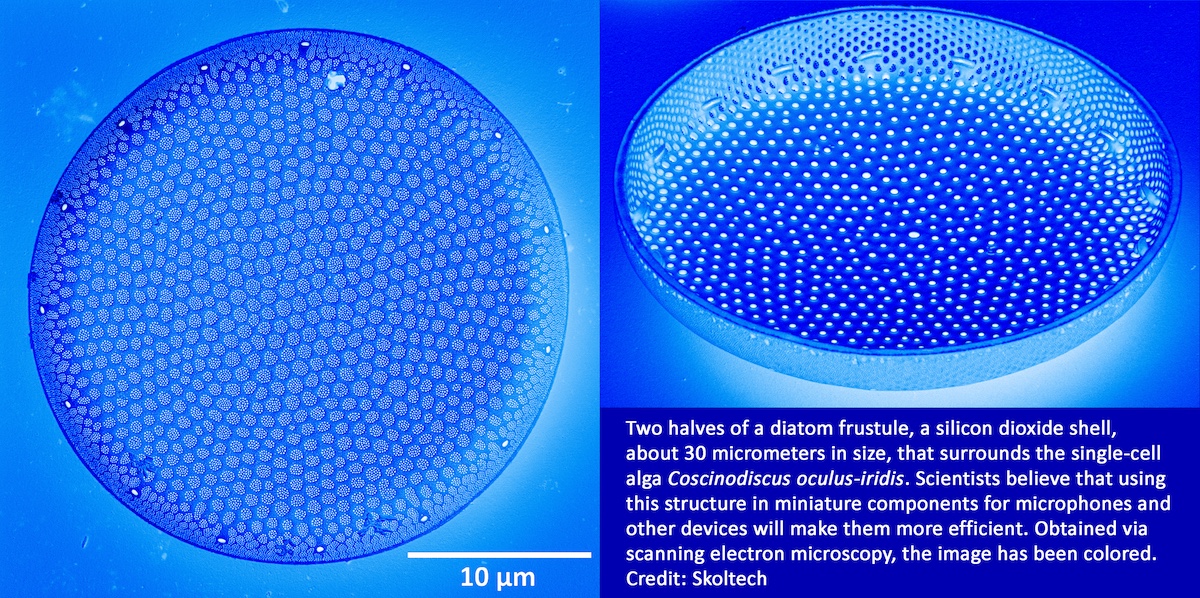A multidisciplinary team of researchers from Skoltech has discovered the resonance frequencies of diatom frustules. These are the intricately structured silicon dioxide shells of single-celled microalgae. They are a promising model for nature-inspired electronic and optical devices, such as tiny ultrasound detectors for advanced medical imaging, and components for ultrafast signal processing in microchips of the future. But it will take a better understanding of diatom frustule properties for these exciting applications to happen, and the new study in Applied Physics Letters is an important step in that direction.
Accounting for about one-fifth of the Earth’s oxygen supply and a quarter of the planet’s biomass, diatom algae are a principal component of plankton and a ubiquitous life form found in the oceans, waterways, and soils of the world. The evolutionary success of diatoms — with their hard and lightweight shells made of silicon dioxide and marked with intricate hole patterns — has led scientists to study their properties and structure and exploit them in a range of materials and consumer goods, from metal polishing abrasives and toothpaste to water purification systems and cat litter. Now, techier applications are awaiting their turn.
“This study combines computer simulations with an experiment,” the paper’s lead author, Skoltech Research Scientist Julijana Cvjetinovic, commented. “The simulations enabled us to predict the resonance frequencies of diatoms within the 1-8 MHz range, and we used an atomic force microscope to furnish the first-ever experimental validation of these frequencies.” The measurements were performed by Skoltech Senior Research Scientist Sergey Luchkin.
Knowing the resonance frequencies of these microscopic structures is crucial for exploiting their design, optimized by nature, in tiny devices that combine moving parts with optics (photonic integrated circuits, or PICs) or with electronics (microelectromechanical systems, aka MEMS devices): the microphones in portable devices, the pressure sensors in car tires, the accelerometers in virtual reality gear, the speakers for in-ear hearing aids, the sensors at the heart of aircraft navigation systems, etc.
“In such devices, structures emulating diatom shells could be used as primary components, and in this regard, our findings are particularly relevant to the design of microphones and other vibration-based sensors,” Cvjetinovic said. “But besides that, they could serve as vibration dampers. You see, in devices operating at such a small scale, even comparatively slight vibrations can adversely affect performance. And structures mimicking diatom frustules could mitigate that.”
The study’s co-principal investigator, Skoltech Professor Dmitry Gorin, who heads Skoltech’s Biophotonics Lab, zoomed in on one of the potential applications in microphones: “Our laboratory is pursuing an advanced medical diagnostic technique called optoacoustics, which involves exciting ultrasound vibrations in certain objects — blood cells, capillaries, vessels, etc. — in the body with thermal deformation induced by a laser pulse and then pinpointing their locations via very sensitive ultrasound detectors. It’s a precise and X-ray-free imaging technique that could benefit from PIC-based ultrasound detectors with membranes emulating diatom shells.”
Previously, Skoltech researchers proposed an optoacoustic endoscopic probe for microsurgery and medical diagnostics. They also put a scanning electron microscope to use in an exacting experiment that revealed how the static and dynamic mechanical properties of diatom frustules are related to their structure. This knowledge informed the computer simulation in the recent paper in Applied Physics Letters, which would also have been impossible without the pioneering theoretical work on diatom resonant frequency calculation by Skoltech Professor Alexander Korsunsky, who was the co-principal investigator on the new study as well.
The possibilities for continuing this line of inquiry, according to the team, include developing artificial diatom-inspired structures and studying their integration into PIC-based ultrasound detectors as highly sensitive membranes.
The research reported in this story is a multidisciplinary collaboration of the Photonics, Energy, and Engineering centers of Skoltech, supported by the Russian Science Foundation (Grant No. 22-14-00209).
Contact information:
Skoltech Communications
+7 (495) 280 14 81

